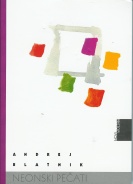|

Neonski pečati. Književnost v digitalnem času.
LUD Literatura, Ljubljana 2005.
Knjiga je
bila finalistka za Rožančevo nagrado 2006.
Vsebina:
Mono
Zgodba o želji: V smrtni uri Willama Faulknerja, 1930
Puščavsko hrepenenje in hlad: Zavetje
neba Paula Bowlesa, 1949 Neprilagojeni: Varuh v rži Jeroma Davida Salingerja, 1951
Izgubljeni ameriški sen: Klavnica
pet Kurta Vonneguta, 1969
Revolucija žre svoje otroke: Grobnica
za Borisa Davidoviča Danila Kiša, 1976
Nakupovanje
do smrti: Beli šum Dona DeLilla, 1984
Prodajni
katalog ničevosti: Manj
kot nič Breta Eastona Ellisa, 1985
Iskanje
afroameriške identitete: Ljubljena
Toni Morrison, 1987
Televizija,
osnovna celica: Vineland
Thomasa Pynchona, 1990
Iz
lastne v javno sobo: Ure
Michaela Cunninghama, 1998
Slabo
pokopani mrtveci: Anilin
duh Michaela Ondaatjeja, 2000
Romani
našega življenja ne bodo spremenili našega življenja:
Popravki Jonathana
Franzena, 2001
Stereo
Blagovna
znamka: pisatelj
Oblika
kot prehod: od podobe do hiperteksta
Kdo
mori slovenske žanrske pisce?
Avtorji
samo za vaše oči: literarno nastopanje
Surround
Prihodnost
književnosti je razbrati v
zadnjem zapisanem stavku
Borges
in jaz (in jaz)
Kdo
si zna napisat sodbo sam?
Vrhunci
stoletja – trenutki razmisleka?
Kratka
zgodba zapušča dom
Razširitev
področja boja
Zgodovina
Navajana
literatura
Imensko
kazalo
Summary:
Neon Seals begins
with twelve autonomous yet connected studies of
contemporary works, all but one (a collection of
short stories A
Tomb for Boris Davidovich by Danilo Kiš), North
American novels: As
I Lay Dying by William Faulkner, The
Sheltering Sky by Paul Bowles, The
Catcher in the Rye by J. D. Salinger, Slaughterhouse
Five by Kurt Vonnegut, White
Noise by Don DeLillo, Less
Than Zero by Bret Easton Ellis, Beloved
by Toni Morrison, Vineland
by Thomas Pynchon, The
Hours by Michael Cunningham, Anil’s
Ghost by Michael Ondaatje, and The
Corrections by Jonathan Franzen. These
monographic studies expose the influence of popular
culture on the contents of, and the literary
procedures employed in, these twelve works, a theme
that is further explored in the second part of the
book. In the 20th century, popular
culture played an important part in forming personal
and social identities. It influenced the production
processes of not only the typical products of
cultural industry, but also of those art disciplines
that are referred to as “classical.” Authors now
place on the market more than their writings: their
names have become trademarks and their public
readings Gesamtkunstwerk. A special case is
hypertext, where even the external, physical
existence of a literary work has changed. At the
same time, hypertext enables a withdrawal from the
historically established form of publishing a
literary work, since it dispenses with a number of
mediators between the author and the reader. This,
however, is not in itself the greatest innovation,
nor is the use of the new medium; through centuries,
literature has used a wide variety of media – from
clay plates to (predominantly) paper – and forms
of their distribution. What gives a work of art its
crucially new position is the recipient’s ability
to actively contribute to its final structure.
Despite
being greatly affected by popular culture, literary
works of the 20th century ‘western
canon’ did not assume the conventional
representation codes typical of popular culture,
which would have directed the reader's responses and
expectations and transformed literary works
(traditionally defined as unique) into serialized
products of popular culture industry. The impact of
popular and media culture caused another problem: a
change in the socialization of a literary work. The
dictate of the mass market and brand names, and the
new forms of representation of art, have altered the
ways in which a work of art exists, and reduced the
chances for an integral and radically innovative
work of art to emerge, exist and be recognized as
such. When an autonomously created literary work
begins its socialization (by being ushered, in
manuscript form, into the publishing industry, which
is followed by distribution, promotion, and, last,
consumption) it has less autonomy than ever, despite
the theoretically easier access to a literary work
than before. The same representation mechanisms that
enable a literary work to be accessible to the
public have reduced its organic autonomy. This is
the basic paradox of the present social position of
any work of art.
|